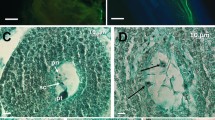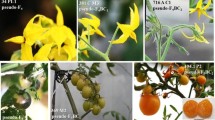Summary
Leaf mesophyll protoplasts of Lycopersicon esculentum (2n=2x=24) were fused with suspension culture-derived protoplasts of Solanum lycopersicoides (2n=2x=24) and intergeneric somatic hybrid plants were regenerated following selective conditions. A two phase selection system was based on the inability of S. lycopersicoides protoplasts to divide in culture in modified medium 8E and the partial inhibition of L. esculentum protoplasts by the PEG/DMSO fusion solution. At the p-calli stage, putative hybrids were visually selected based on their hybrid vigor and lime-green coloration in contrast to slower growing parental calli characterized by a watery, whitish-brown coloration. Early identification of the eight hybrid plants studied was facilitated by isozyme analysis of leaf tissue samples taken from plants in vitro at the rooting stage. Regenerated plants growing in planting medium were further verified for hybridity by 5 isozymes marking 7 loci on 5 chromosomes in tomato. These included Skdh-1 mapped to chromosome 1 of tomato, Pgm-2 on chromosome 4, Got-2 and Got-3 on chromosome 7, Got-4 on chromosome 8, and Pgi-1 and Pgdh-2 both on chromosome 12. Fraction I protein small subunits further confirmed the hybrid nature of the plants with bands of both parents expressed in all hybrids. The parental chloroplasts could not be differentiated by the isoelectric points of the large subunit. Seven of the eight somatic hybrids had a chromosome number ranging from the expected 2n=4x=48 to 2n=68. Mixoploid root-tip cells containing 48, 53, 54 or 55 chromosomes for two of the hybrids were also observed.
Similar content being viewed by others
References
Cammaerts D, Jacobs M (1980) A simple electrophoretic procedure for the determination of the polypeptide composition of the subunits of fraction I protein. Anal Biochem 109:317–320
Handley LW, Sink KC (1985a) Plant regeneration of Solanum lycopersicoides Dun. from stem explants, callus and suspension cultures. In: Plant cell, tissue and organ culture (in press)
Handley LW, Sink KC (1985b) Plant regeneration of protoplasts isolated from suspension cultures of Solanum lycopersicoides. Plant Sci (in press)
Herner RC (1982) Chilling injury in tomato. In: Symp Plant Responses to Environmental Stress. Annu Meeting AAAS, Washington DC
Herner RC, Kamps T (1983) Chilling injury tolerance of wild tomato species. In: Proc 4th Tomato Quality Workshop. Veg Crops Res RPT VEC-83-1
Meinzel S, Markert CL (1967) Malate dehydrogenase isozymes of the marine snail Ilyanassa obsoleta. Arch Biochem Biophys 122:753–765
Menczel L, Wolfe K (1984) High frequency of fusion induced in freely suspended protoplast mixtures of polyethylene glycol and dimethylsulfoxide at high pH. Plant Cell Rep 3:196–198
Murashige T, Skoog F (1962) A revised medium for rapid growth and bioassays with tomato tissue cultures. Physiol Plant 15:473–497
Niedz RP, Rutter SM, Handley LW, Sink KC (1985) Plant regeneration from leaf protoplasts of six tomato cultivars. Plant Sci 39:199–204
Patterson BD, Paull R, Smillie RM (1978) Chilling resistance in Lycopersicon hirsutum Humb. & Bpnpl., a wild tomato with a wide altitudinal distribution. Aust J Plant Physiol 5:609–617
Rick CM (1951) Hybrids between Lycopersicon esculentum Mill. and Solanum lycopersicoides Dun. Proc Natl Acad Sci USA 37:741–744
Rick CM (1983) Tomato (Lycopersicon) In: Tanksley SD, Orton TJ (eds) Isozymes in plant genetics and breeding, part B. Elsevier, Amsterdam, pp 147–165
Rick CM, Fobes JF (1977) Linkage relations of some isozymic loci. Rep Tomato Genet Coop 27:22–24
Scandalios JG (1969) Genetic control of multiple molecular forms of enzymes in plants: A review. Biochem Genet 3:37–79
Schieder O (1980) Somatic hybrids between a herbaceous and two tree Datura species. Z Pflanzenphysiol 98:119–127
Scott SJ, Jones RA (1982) Low temperature seed germination of Lycopersicon species evaluated by survival analysis. Euphytica 31:869–883
Shepard JF, Bidney D, Barsby T, Kemble R (1983) Genetic transfer in plants through interspecific protoplast fusion. Science 219:683–688
Tanksley SD (1979) Linkage, chromosomal association and expression of Adh-1 and Pgm-2 in tomato. Biochem Genet 17:1159–1167
Tanksley SD (1980) PGI-1, A single gene in tomato responsible for a variable number of isozymes. Can J Genet Cytol 22:271–278
Tanksley SD, Kuehn GD (1985) Genetics, subcellular localization, and molecular characterization of 6-phosphogluconate dehydrogenase isozymes in tomato. Biochem Genet 23:441–454
Tanksley SD, Rick CM (1980) Isozymic gene linkage map of the tomato: applications in genetics and breeding. Theor Appl Genet 57:161–170
Vallejos CE (1979) Genetic diversity of plants for response to low temperature and its potential use in crop plants. In: Lyons JM, Graham D, Raison JK (eds) Low temperature stress in crop plants, the role of the membrane. Academic Press, New York, pp 473–489
Vallejos CE (1983) Enzyme activity staining. In: Tanksley SD, Orton TJ (eds) Isozymes in plant genetics and breeding, part A. Elsevier, Amsterdam, pp 469–516
Vallejos CE, Tanksley SD (1983) Segregation of isozyme markers and cold tolerance in an interspecific backcross of tomato. Theor Appl Genet 66:241–247
Author information
Authors and Affiliations
Additional information
Communicated by H.F. Linskens
Michigan Agricultural Experiment Station Journal Article No. 11736. Supported by Grant No. I-751-84R from BARD — The United States — Israel Binational Agricultural Research and Development Fund
Rights and permissions
About this article
Cite this article
Handley, L.W., Nickels, R.L., Cameron, M.W. et al. Somatic hybrid plants between Lycopersicon esculentum and Solanum lycopersicoides . Theoret. Appl. Genetics 71, 691–697 (1986). https://doi.org/10.1007/BF00263265
Received:
Accepted:
Issue Date:
DOI: https://doi.org/10.1007/BF00263265




